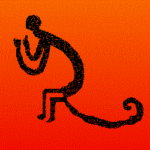 Only the manufacturer of a rock art image could reliably have informed us whether a rock art image is unfinished or whether it is incomplete. Unfortunately informed knowledge is often completely unavailable. Then only the image and its graphical and cultural context are available to possibly separate the unfinished from the incomplete. Additionally, the incomplete image may even include something invisible. To address these issues I will use the rich rock art repertoire of the Desert Andes, focussing mainly on Toro Muerto and Miculla, two enormous rock art sites in the south of Peru.
Only the manufacturer of a rock art image could reliably have informed us whether a rock art image is unfinished or whether it is incomplete. Unfortunately informed knowledge is often completely unavailable. Then only the image and its graphical and cultural context are available to possibly separate the unfinished from the incomplete. Additionally, the incomplete image may even include something invisible. To address these issues I will use the rich rock art repertoire of the Desert Andes, focussing mainly on Toro Muerto and Miculla, two enormous rock art sites in the south of Peru.
By Maarten van Hoek
*
The Incomplete Versus The Unfinished
Invisible Objects in Desert Andes Rock Art?
*
Maarten van Hoek – rockart@home.nl
INTRODUCTION
All over the world millions of rock art images have been manufactured. Those images may be pictographs, images painted onto natural rock surfaces, or petroglyphs, images carved out of the natural rock surface. To the untrained eyes of the western-minded and modern layperson those images often seem to be complete. Yet numerous images that are clearly unfinished and/or incomplete have been recorded by well-trained rock art researchers globally. But even for an experienced, professional archaeologist and expert in rock art recording, it is often impossible to determine whether an incomplete or an unfinished image has been manufactured, often long ago. In fact, only the manufacturer of the rock art image could reliably inform us whether an unfinished image was the result or whether an incomplete image was aimed at. But unfortunately informed knowledge is (almost always) completely unavailable. Therefore only the image and its graphical and cultural context are available to possibly separate the unfinished from the incomplete and even then the issue is hard to unravel. Therefore, the problem that I would like to discuss here concerns the issue how to determine whether a rock art image involves an unfinished image or an incomplete image. Additionally, the incomplete image may even include something invisible. But there is a second problem. It concerns the lexical semantics of the words unfinished and incomplete. For many people those two words will be the same (and often they are). Therefore we have to clearly define what those two words mean in this study.
To address these two issues I will use the rich rock art repertoire of the Desert Andes, focussing mainly on Toro Muerto and Miculla, two enormous rock art sites in the south of Peru. During the past twenty years I recorded thousands of petroglyphs in that area and – although most images seem to be complete – in several cases I still noticed that specific petroglyphs proved to be incomplete or unfinished.
As abstract images are not suitable to address those issues I will almost exclusively focus on biomorphic imagery, mainly birds, quadrupeds, monkeys and anthropomorphs. Despite this restriction, I will start with an unambiguous example of an unfinished abstract petroglyph to first illustrate the concept of unfinished. In 1984 I discovered a petroglyph at Buttony-6, Northumberland, British Isles, an archipelago very rich in the so-called Neolithic ‘Cup-and-Ring Art’ (Van Hoek 1999). The deeply carved petroglyph proved to be a rare bisected Cup-and-Ring motif that clearly showed an unfinished part comprising an arc of small cupules in the outer ring (Figure 1). This probably was how the whole motif was initially laid out, but obviously the outer ring was never finished. There are a few more examples of this technique in the archipelago (for instance at Ormaig, Scotland).
Figure 1. Unfinished Cup-and-Ring motif at Buttony, Northumberland, England. Photograph © by Maarten van Hoek.
Click any Figure to enlarge
*
Defining Incomplete and Unfinished
In this study incomplete concerns the situation in which an image is intentionally lacking specific details, like arms or a head, or an element, like an eye or even an object. Yet, for the layperson an image of a person without eyes will appear to be incomplete. However, by intentionally omitting specific elements (like the eyes, the arms or an object) the manufacturer may have had an explicit purpose. He or she possibly added an exclusive layer of symbolism, a hidden meaning deviant from the other nevertheless similar images and thus also conveyed a special symbolism and/or message to the audience (whether divine or secular) he or she created the image for. Another possibility that may explain an incomplete image is the fact that the manufacturer decided for strictly personal reasons to omit something, for instance as an act of rebellion. Such expressions of individuality can never be excluded, but are hard to prove.
On the other hand an unfinished image is an image that was started, but for some reason was never finished. The creation of the image was (unexpectedly or deliberately) abruptly interrupted and/or abandoned, while in first instance a complete image had been the goal of the manufacturer. Therefore, the defining factor to separate incomplete from unfinished imagery is whether intent or not is involved. Although those definitions offer a workable basis, in the practice in the field it is often still rather ambiguous whether an image is unfinished or incomplete. A number of examples will demonstrate this, starting with unfinished examples.
*
Unfinished Rectangular Birds
Toro Muerto – the largest rock art site in the Majes Valley and of the whole of Peru – is very rich in all types of bird petroglyphs that are depicted either fully laterally or fully frontally (although the head has always been depicted laterally). One type of bird that (almost) exclusively has been recorded in the Majes Valley is the Rectangular Bird. This type of bird is almost always depicted outlined (there are extremely few fully pecked examples) and always fully laterally (Van Hoek 2018: 114 – 118).
If we compare the ‘ideal’ representation of this bird (Figure 2A) with other petroglyphs of this bird at Toro Muerto (Figures 2B to D), then it will be clear that several examples are definitely unfinished. Bird A – the most complete image – has a body, a wing (the vertical line) with feathers (the horizontal lines), a tail with horizontally arranged feathers and a leg with a foot (some examples have two legs). Bird B has no feet, no feathers and apparently no beak. The wing is just a single, vertically arranged line, clearly unfinished. Bird C has no feathers, no tail-feathers and no legs. Again the wing is just a single line. There is also an example only without a wing. Bird D has no feathers, no wing, no tail-feathers and no legs. It is understandable that petroglyph D will not have been recognised as a bird image. It equally may have been interpreted as an unfinished quadruped image, like the unfinished example of a quadruped (camelid?) on Boulder TM-Ba-001 (Figure 3; see also Figure 18).
Figure 2. Unfinished petroglyphs of the Rectangular Bird (B to D) at Toro Muerto, Peru. Photographs © by Maarten van Hoek.
It unmistakably proves that only the graphical context of bird imagery at Toro Muerto definitely classifies petroglyph D as a bird. Most examples of the Rectangular Bird in the Majes Valley have no eye and thus may be considered to be incomplete. Only in a very few cases Rectangular Birds have a dot for an eye or (even more exceptional) a circular outlined eye.
Figure 3. Unfinished petroglyph of a quadruped (right) at Toro Muerto, Peru. Photograph © by Maarten van Hoek.
*
Unfinished Curvilinear Birds
Toro Muerto, and – to a (much) lesser extent Alto de Pitis and some other sites in the Majes Valley – are very rich in the examples of the Curvilinear Bird. Also this bird is always depicted fully laterally but appears in many different techniques (fully outlined, fully pecked and many combinations). If again we compare the ‘ideal’ representation of this bird (Figures 4B1 and 5A) with other petroglyphs of this bird (Figures 4A and 4B2 and 5B), then again it will be clear that several examples at Toro Muerto are definitely unfinished. Bird 4A has no tail and no legs, while birds 4B2 and 5B have no bodies; just the head has been depicted, which – although rather common for human heads – is very unusual for birds.
Figure 4. Unfinished petroglyphs of birds at Alto de Pitis, Peru. Photographs © by Maarten van Hoek.
Figure 5. Unfinished petroglyph of a bird (B) at Toro Muerto, Peru. Photograph © by Maarten van Hoek.
*
Unfinished Frontally Depicted Birds
Also occurring at Toro Muerto are several petroglyphs of fully frontally depicted birds with (horizontally) outspread wings and drooping (vertically arranged) feathers (Figure 6A). Also this type of bird appears in unfinished form on a few panels (Figures 6B and C). Figure 6B apparently misses a complete wing and Figure 6C is missing most of the feathers.
Figure 6. Unfinished petroglyphs of birds (B and C) at Toro Muerto, Peru. Photographs © by Maarten van Hoek.
*
Unfinished Snakes
Toro Muerto and other sites in the Majes valley have numerous examples of snake petroglyphs. In most cases the complete snake has been depicted (Figure 7A), but in a few exceptional cases only the head of a snake has been depicted (Figure 7B). On Boulder TM-Ba-001 another isolated snake head occurs next to an unfinished quadruped (see Figure 3) and an unfinished head of a quadruped. A possibly unfinished snake petroglyph occurs on Boulder TM-Ab-006 at Toro Muerto next to a clearly unfinished feline. An equally rare example of an isolated snake head was recorded by me in 2017 at the rock art site of Cerro Blanco near the hamlet of Susanga in the Virú drainage of northern Peru (Figure 7C).
Figure 7. A: Snake at Toro Muerto; B: Unfinished petroglyph of a snake at Toro Muerto, Peru; C: Unfinished snake at Susanga, northern Peru. Photographs © by Maarten van Hoek.
*
Unfinished Felines
Petroglyphs of felines occur abundantly at Toro Muerto and Alto de Pitis. Most of the complete images of felines represent outlined and laterally depicted examples with in most cases a frontally depicted head featuring most facial features (whiskers, nose, eyes and/or mouth). The bodies and the legs and tail are in most cases lavishly decorated with dots, lines and/or circles (Figure 8A). Figure 8B shows an unfinished feline petroglyph at Toro Muerto of which the head and front leg are missing. To its left is the possibly unfinished snake. At Alto de Pitis is a petroglyph of a feline without a front leg (Figure 8C). At Toro Muerto are two more boulders with an unfinished feline. Figure 9 shows the outlined head (without facial features or any other decoration) and part of the back-line, while Figure 10 shows a similar, yet more complete feline that misses the front leg, the belly-line and all of the possible internal decoration.
Figure 8. Unfinished petroglyphs of felines at Toro Muerto (B and D) and Alto de Pitis (C), Peru. Photographs © by Maarten van Hoek.
Figure 9. Unfinished petroglyph of a feline at Toro Muerto, Peru. Photographs © by Maarten van Hoek.
Figure 10. Unfinished petroglyph of a feline at Toro Muerto, Peru. Photographs © by Maarten van Hoek.
Also at Toro Muerto is a large boulder with two groups of small cupules that may have been intended to form the internal decoration of two felines, but the outlines are missing. Moreover, just hovering over the right end of the upper group is the head of a feline, which seems to confirm my hypothesis that the figures are unfinished (Figure 8D). Those two groups of cupules brings us to another group of unfinished zoomorphic images at Toro Muerto.
*
Unfinished Zoomorphs with Internal Cupules
Several zoomorphic petroglyphs at Toro Muerto are composed of only small cupules. There is no outlined body. This may be an intentional choice and those examples may represent the complete image as desired by the manufacturer (van Hoek 2016). However, in a few cases it is obvious that the manufacturer started the body line, but did not finish the whole animal. Figure 11 shows a group of petroglyphs that include a ‘Carcancha’ (a Skeleton-Anthropomorph) and a feline with an unfinished head (see Van Hoek 2013, 2018 and 2019 for more information about ‘Carcanchas’). The layout of the ‘Carcancha’ will be relevant later on. Figure 12A shows un unidentifiable zoomorph that is for the most part unfinished. In case of the petroglyph in Figure 12B the manufacturer finished more cupules, while the neck of the still unidentifiable zoomorph is visible. The petroglyph in Figure 12C is missing the head, the tail and the claws of the front leg. Because of the claws depicted at the hind leg it probably was intended to draw a feline.
Figure 11. Unfinished petroglyph of a feline (left-hand side) at Alto de Pitis, Peru. Photograph © by Maarten van Hoek.
Figure 12. Unfinished petroglyphs of (A and B) quadrupeds at Toro Muerto; (C) at Alto de Pitis, Peru. Photographs © by Maarten van Hoek.
*
Unfinished Zoomorphs
In several cases it is uncertain exactly which animal species was intended. The petroglyph in Figure 13A could have been intended as a bird (Figure 13B), but equally as a feline, an unfinished example of which is shown in Figure 13C. Figure 14A shows the head of an animal that – when finished – most likely would look like the complete zoomorphic petroglyph in Figure 3. Figure 14B only seemingly depicts a complete quadruped. However it is missing its hind leg, as in fact the alleged hind leg is an image of the well-known Majes ‘dancer’, superimposed by the zoomorph. Figures 14C and D are other examples of unfinished zoomorphs.
Figure 13A and C. Unfinished petroglyphs of zoomorphs at Toro Muerto, Peru. Photographs © by Maarten van Hoek.
Figure 14. Unfinished petroglyphs of quadrupeds at Toro Muerto, Peru. Photographs © by Maarten van Hoek.
*
Unfinished Anthropomorphs
There are numerous anthropomorphic petroglyphs in the Majes Valley, mainly comprising images of the Majes ‘dancer’. Equally interesting are the relatively many examples of petroglyphs of ‘Carcanchas’, anthropomorphic figures with skeletal properties that express the Andean life-death duality because of the often exposed sexual organs (see Figure 12). One petroglyph of a ‘Carcancha’ seems to be unfinished as only one half of its rib-cage has been depicted (Figure 15A). It only seemingly misses a leg, but its left leg has almost weathered off.
Images of the Majes ‘dancer’ often seem to be incomplete. For instance on the vertical face of a very large boulder are some petroglyphs of the ‘dancer’, some of which only seemingly are incomplete. ‘Dancer’ C in Figure 16 has no feet and no eyes and thus seems to be incomplete. However, it is customary that ‘dancers’ are depicted with two eyes, with only one eye (like in ‘dancers’ A and B) or without eyes. Similarly, ‘dancers’ are sometimes depicted with feet (see ‘dancer’ A) or (in most cases) without feet (see ‘dancer’ B), with hands or no hands, and with feet or hands with (two to four) digits or without digits. Therefore it is almost impossible to classify a ‘dancer’ as incomplete. I have recorded more than 1100 examples of the Majes ‘dancer’, which appear in many different ways, but hardly ever an unfinished could be spotted. One certain example of an unfinished ‘dancer’ is shown in Figure 15B next to a complete example.
Figure 15. Unfinished petroglyph of anthropomorphs at (A) Alto de Pitis; unfinished ‘dancer’ (B) and complete anthropomorph (C) at Toro Muerto, Peru. Photos © by Maarten van Hoek.
Figure 16. Petroglyphs of ‘dancers’ at Toro Muerto, Peru. Photograph – not rotated – © by Maarten van Hoek.
Figure 15C shows an anthropomorphic (?) petroglyph that only seemingly is unfinished (or incomplete) as the head seems to be missing. However, the rock art of the Majes Valley (mainly of Toro Muerto) includes bands of fully pecked stripes that are usually rather long, although short stripes also occur (see Figure 18C). Some of those stripes have been anthropomorphised by adding legs and/or feet. This example of a short stripe and its legs and feet may therefore be regarded as a complete image despite the missing head, arms and other details.
*
Unfinished Re-pecking
Finally, there are petroglyphs that clearly have been re-pecked at a much later time. However in a few cases the re-pecking was not finished. A good example has been recorded at the Lasana rock art site along the Río Loa in northern Chile (photo unavailable), but also at Toro Muerto an example occurs. Figure 17 shows a clearly re-pecked camelid petroglyph of which the ears still show the original pecking, which also shows in the other petroglyphs of large camelids. However, fully re-pecked images could well represent petroglyphs that have been added much later without involving the re-pecking of an earlier image.
Figure 17. Unfinished, re-pecked petroglyph of a quadruped at Toro Muerto, Peru. Photograph, much enhanced © by Maarten van Hoek.
Concluding, in the Majes Valley numerous examples of several types of biomorphs have been recorded. In most instances those images are complete. However, a relatively high number of petroglyphs proved to be unfinished. But only the general context of the imagery in this important valley in southern Peru proves to offer evidence for those images being unfinished. For instance, Petroglyph A in Figure 18 would hardly ever have been recognised as an unfinished bird, not even when it would have been compared with Petroglyph B on the same panel. Only the whole context at Toro Muerto would establish Petroglyph A as an unfinished bird image.
Figure 18. Unfinished petroglyph of a Rectangular Bird (A) at Toro Muerto, Peru. Photograph © by Maarten van Hoek.
*
INCOMPLETE IMAGES
It is surprising to see that especially in the Majes Valley so (relatively) many unfinished petroglyphs occur. That does not mean that other sites in the Desert Andes or elsewhere in the world do not have unfinished or incomplete images. There probably are numerous examples globally. For instance, at the extensive petroglyph site of Miculla in the south of Peru, there is at least one clearly unfinished zoomorphic petroglyph, most likely a camelid (Figure 19), while at the rock art site of Ofragía in northern Chile an unfinished archer has been recorded by me.
Figure 19. Unfinished petroglyph of a quadruped at Miculla, southern Peru. Photograph © by Maarten van Hoek.
Yet, Miculla also has some interesting incomplete images. Miculla has many petroglyphs of anthropomorphs with arms, often holding objects like bows or purported flutes. But there are also images of similar anthropomorphs with legs and often with a headgear, but without arms (Figure 20). Those figures without arms are definitely not unfinished (although modern vandals sometimes added scratched arms). Those anthropomorphs are manufactured intentionally incomplete, but for a reason that is unknown to me (I have never read an explanation in the literature that I have available). Such arm-less figures also have been reported 75 km further NW in the Locumba Valley, for instance at the rock art sites of Tumbaya and San Antonio.
Figure 20. Incomplete petroglyphs of arm-less anthropomorphs at Miculla, southern Peru. Photos © by Maarten van Hoek.
Contextual proof for not being unfinished is also found elsewhere in the region. About 65 km to the south, in the valleys of Lluta and Azapa in northern Chile, are many large geoglyphs, the style of which is not repeated elsewhere in Chile. Those geoglyphs also include a large number of arm-less anthropomorphic geoglyphs and yet all those arm-less figures are definitely complete (Figure 21B1). Moreover, in those valleys are also many zoomorphic geoglyphs. Some of those zoomorphic geoglyphs depict a monkey (for instance at Site Lluta-111, Panel 11), or a canine, possibly a fox (for instance on Panel 10). Importantly, both types of animals (Figures 21A and B2) are in a most atypical position that – just possibly – may relate to the concept of the invisible object in Andean (rock) art.
Figure 21. Geoglyphs from the Lluta Valley, northern Chile. Drawings © by Maarten van Hoek, A: based on Luis Briones 1984: Fig. 12; B: based on a photo by Marijn van den Brink.
*
In order to access the subject of the invisible object in (rock) art, I would like to discuss another class of incomplete imagery that is also found at Miculla (313 km SE of Toro Muerto). While Toro Muerto has only three (regionally unique) petroglyphs of purported ‘flute-players’ (Van Hoek 2010), on the other hand Miculla – and several other sites in this border region – has relatively many petroglyphs of supposed ‘flute-players’. Surprisingly, ‘flute-players’ at Miculla are both anthropomorphic and zoomorphic (at least one petroglyph of a monkey at Miculla is ‘playing the flute’). However, at Miculla there is also one petroglyph of a laterally depicted anthropomorph that only seemingly is ‘playing the flute’ (Figure 22), but the ‘flute’ is missing (despite ugly recent scratches that were meant to add the ‘flute’, which proves that the vandal also interpreted the figure as ‘playing the flute’). This may be an example of an unfinished image, but equally it may have been the premeditated intention not to draw the ‘flute’. And this is not an isolated example.
Figure 22. Complete (?) petroglyph of purported ‘flute-player’ at Miculla, southern Peru. The scratching is recent vandalism. Photograph © by Maarten van Hoek.
Earlier (Van Hoek 2003: 157; Fig. 9O) I suggested that also a petroglyph of a biomorph at Toro Muerto was holding an ‘invisible flute’, although it seems to be more likely that the petroglyph represents (or has been turned into?) a biomorph that ‘spits’ or ‘produces sound’; a true hallmark at Toro Muerto.
However, the (possibly) premeditated omission of an object in rock art (such as a ‘flute’) also occurs in a very rare scene on a boulder at Pakra in the valley of the Río Pisco (753 km NW of Miculla; site partially built-over after our published survey: Van Hoek 2005a) where three monkeys are ‘playing some sort of wind-instrument’ (the instrument of one monkey being incomplete due to recent damage). Notice that the triangular ends of the wind-instruments are quite large and are less clearly visible; later additions? (Figure 23).
Figure 23. Petroglyphs of monkeys at Pakra, Pisco Valley, southern Peru. Photograph and drawing © by Maarten van Hoek.
Of special interest however is the fourth monkey, which features exactly the same posture as the other three ‘instrument playing monkeys’, without, however, holding an instrument (Figure 23). This example may be an instance of an unfinished petroglyph, but it is more likely that it represents a ‘pars pro toto’ image. This means that it may have been a deliberate decision not to equip that ‘monkey’ with a ‘wind-instrument’. Possibly it was understood by the ancient audiences that this ‘empty-handed monkey’ is playing a wind-instrument as well. In that case the fourth monkey may be considered to play an invisible instrument, however only because of the graphical context of the rest of the panel (and other ‘similar’ rock art images at Pakra and elsewhere). If only one monkey had uniquely been manufactured in this position, it could have been an unfinished image or – perhaps more likely – a fully complete image. Importantly, the Pakra monkey ‘playing an invisible flute’ is not a unique example.
Huancor, an important rock art site 45 km NW of Pakra, not only has a relatively high number of ‘flute-players’ (altogether I have recorded ten anthropomorphic examples), there are also anthropomorphs, often with a typical ‘headdress’, showing the same posture as ‘players’ but without actually holding a ‘wind-instrument’. Moreover, one of those anthropomorphic ‘players’ is depicted in a ‘seated’ position, typical for this area. Also several anthropomorphs at Huancor appear in a similar ‘seated’ position, but without holding a ‘wind instrument’ (Van Hoek 2005b).
Several other zoomorphic rock art images in the same position have been recorded in the Desert Andes, some possibly ‘holding an invisible wind-instrument’ or some other ‘invisible object’. I again refer to the monkey and canine geoglyphs in the Lluta Valley of northern Chile, which have the same pose, but do not hold an object (see Figure 21). Also at Miculla I recorded a petroglyph of a zoomorph in the ‘playing’ pose, but without holding an object, while similarly positioned zoomorphic rock art images are known from Taltape, Cerro Chuño and Apanza in northern Chile, at Huancor in southern Peru and at Cerro Mulato in northern Peru (Van Hoek 2005b).
Finally, in my 2005b publication I suggested that also a geoglyph (not a form of rock art, though) depicts a (possible) example of a monkey ‘playing an invisible wind-instrument’. It is found in the archaeological complex near the town of Nazca in southern Peru, which is world-famous for its enigmatic geoglyphs. The complex also comprises several enormous biomorphic figures and one of them is the well-known ‘Monkey’. Especially the arms and hands of the Monkey have an atypical pose, which is – as far as I can tell – not seen anywhere else in the rich rock art repertoire of the Desert Andes. The distinctive pose of the arms and hands of the Monkey seem to mimic something special, which I now will explain.
In my opinion especially the splayed, curved arms and the hands with splayed digits are intentionally placed in the ‘flute-playing’ position (Figure 24A; notice that the hands are not placed opposite each other, a position which can be expected when playing a flute) and thus it is easy to picture this zoomorph to be ‘playing an invisible flute’, as is tentatively suggested by me in Figure 24B.
Figure 24A: The ‘Monkey’ Geoglyph from the Nasca Complex, southern Peru. B: The same geoglyph ‘completed’ by the author with a ‘flute’. C: Petroglyph of a monkey in a possible ‘playing’ position at Miculla, southern Peru. D and E: petroglyph from Cerro Chuño, northern Chile; E completed by the author with a ‘flute’. Drawings © by Maarten van Hoek, A and B based on Reinhard 1988: Fig. 46.; D and E based on photographs kindly supplied by Renata Aguirre Bianchi.
*
CONCLUSIONS
From this short study it proves that the great majority of the biomorphic rock art images usually comprises complete and finished figures. However, in several cases the manufacture of an image may have been interrupted and abandoned resulting in a clearly unfinished image. The reason for such an interruption will be very hard – or even impossible – to trace because of lack of informed knowledge. Lack of informed knowledge also severely inhibits the explanation of unambiguous examples of images that are allegedly incomplete. Therefore, the reasons to produce incomplete images will always remain uncertain. Consequently, it is still ‘completely uncertain’ if indeed the Nasca Monkey is ‘playing an invisible flute’. Although, is it?
The concept of depicting ‘invisible’ objects in (rock) art – in fact a contradictio in terminis – is in my opinion not far-fetched (although – almost? – impossible to prove). For instance, one time archaeologist Polly Schaafsma labelled a rock art panel at Oljeto Wash, Utah, USA, the Absent Hunter Panel (‘h’ and ‘p’ capitalised by me) because only the petroglyphs of his footsteps (sandals), his (?) handprint and an isolated bow-and-arrow (the arrow aiming at a sheep petroglyph) have been manufactured on the panel, while the archer is absent (Figure 25). I must emphasize however that Schaafsma never even suggested that the archer has been ‘depicted as an invisible person’, or that she suggested that the absence was a premeditated choice in order to ‘reveal’ an invisible person. Those are only my tentative suggestions.
Figure 25. Petroglyphs on the Absent Hunter Panel at Oljeto Wash, Utah, USA. Drawing © by Maarten van Hoek, based on a photograph by Chuck LaRue (Schaafsma 2016: Figure 11).
Much more convincing is the following example. In 1934 Alberto Giacometti, a Swiss artist, created a female figure which he called ‘The Invisible Object (Hands Holding the Void)’. The epicentre of his work is the void between the figure’s hands, the fingers of which are folded in such a way that one almost sees the (spherical) object, which of course is – because of its absence – invisible. But it is interesting to compare the 3D position of the hands-fingers with the 2D position of the hands-fingers of the Nasca Monkey (see Figure 24a). Although the positions are different, the voids express the same absence and thus invisibility.
Reviewing my hypothesis about the non-visual (Van Hoek 2005: 11) a rock art researcher remarked that ‘statements about the non-visual can neither be confirmed nor refuted under any available research paradigm‘. Of course, in general he or she is right, except when informed knowledge is available, like with the Swiss statue. However, if a Swiss artist can materialise the concept of an invisible object, why can prehistoric people/artists from the Desert Andes not use the same concept in their (rock) art? The only thing that is missing is the informed knowledge.
Again, it is the context of the several monkeys ‘playing a wind-instrument’ and several other rock art images of biomorphs ‘holding nothing’ in Desert Andes rock art that makes it very plausible that also the Nasca Monkey ‘plays a wind-instrument’. Therefore, the Nasca Monkey, the Pakra monkey, the Miculla ‘flute-player’ and several other figures mentioned in this study are most likely not unfinished and neither are they incomplete. They may have been manufactured intentionally ‘incomplete’, in order to suggest that they are holding invisible objects. Therefore, they may be regarded to be completely complete in the way the ancient manufacturer intended to visualise the image. But yet, only the manufacturer will have known for sure whether this is true. In my opinion, western-minded (rock) art researchers should always leave open the possibility that the non-visual is part of the image, even when no informed knowledge is available.
*
REFERENCES
Briones, L. 1984. Presentación y valoración de los geoglifos del norte de Chile. Primer Simposio de Arqueología Atacameña, San Pedro de Atacama. Estudios Atacameños. Tomo 7: pp. 296 – 305.
Reinhard, J. 1988. The Nazca lines. A new perspective on their origin and meaning. Pacific Press, Lima.
Schaafsma, P. 2016. Sandals as Icons: Representations in Ancestral Pueblo Rock Art and Effigies in Stone and Wood. In: Arts. Vol. 5-7; pp. 1 – 22.
Van Hoek, M. 1999. Radial grooves. Symbolic paths in cup-and-ring art. StoneWatch. Vol. 4; pp. 8 – 10. Warmsroth, Germany.
Van Hoek, M. 2003. The rock art of Toro Muerto, Peru. Rock Art Research. Vol. 20-2; pp. 151 – 170. Melbourne, Australia.
Van Hoek, M. 2005a. Los Petroglifos de Muralla y Pakra, Valle de Pisco, Perú. Boletín de SIARB, Vol. 19; pp. 28 – 37. La Paz, Bolivia.
Van Hoek, M. 2005b. Biomorphs ‘playing a wind instrument’ in Andean rock art. Rock Art Research. Vol. 22-1; pp. 23 – 34. Melbourne, Australia.
Van Hoek, M. 2010. ‘Trophy’ heads in the rock art of the Majes Valley, Perú: exploring their possible origin. In: Rupestreweb.
Van Hoek, M. 2013. The Carcancha and the Apu. Rock Art in the Death Valley of the Andes. Oisterwijk, The Netherlands.
Van Hoek, M. 2016. Dotted Zoomorphs in Andean Rock Art. In: Rupestreweb.
Van Hoek, M. 2018. Formative Period Rock Art in Arequipa, Peru. An up-dated analysis of the rock art from Caravelí to Vítor. Oisterwijk, Holland.
Van Hoek, M. 2019. The Book of Bones – ‘Carcanchas’ in Global Rock Art. Oisterwijk, Holland.
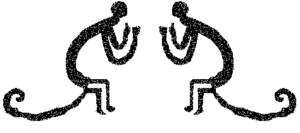
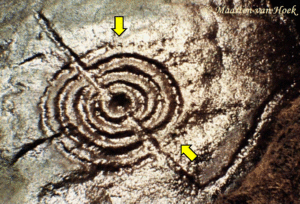
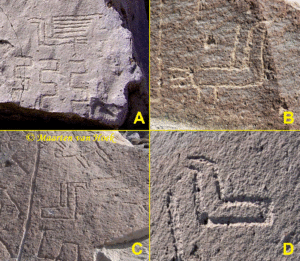
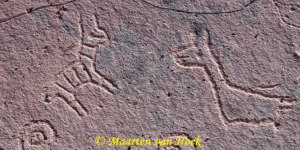
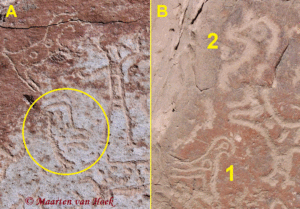
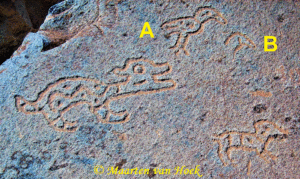


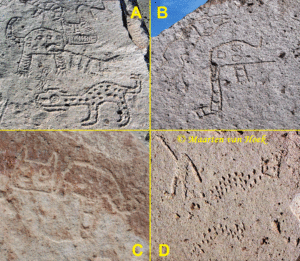
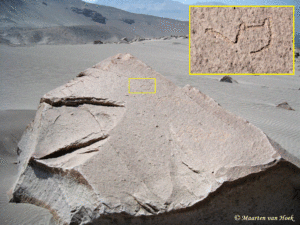
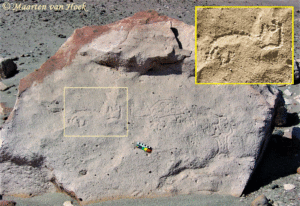
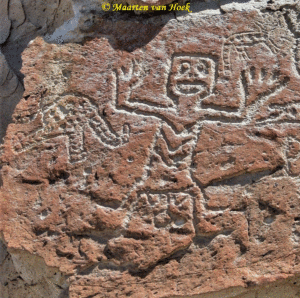


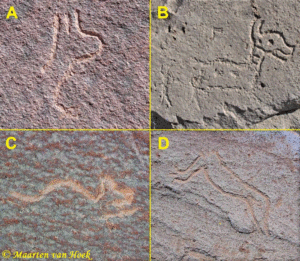
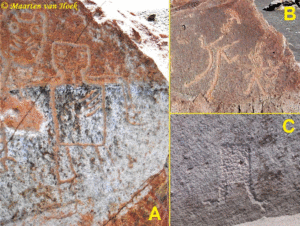
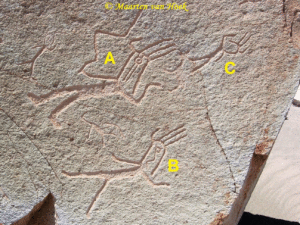
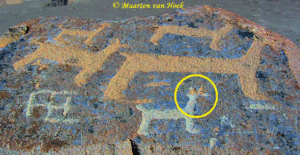
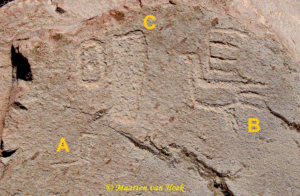
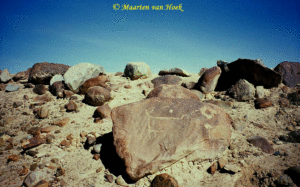
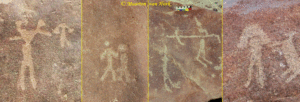
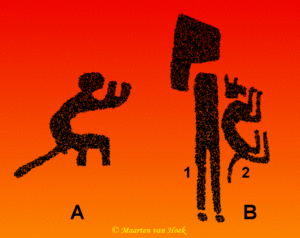
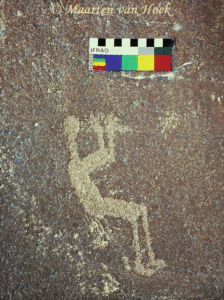
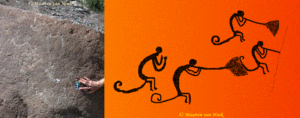
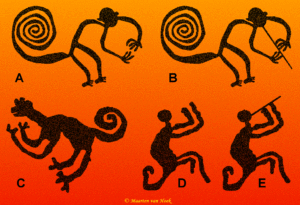
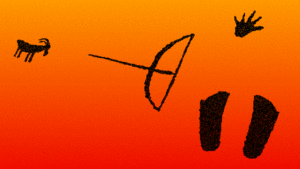














Leave a Reply